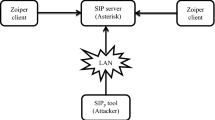Abstract
In an effort to provide lawful interception for session initiation protocol (SIP) voice over Internet protocol (VoIP), an interception architecture using session border controller (SBC) is proposed. Moreover, a prototype based on the proposed architecture is implemented. A testbed is set up and tests are carried out in order to analyze the performance and the capability of function entities and interfaces in the proposed architecture. Test results show that SBC interception capability in SIP signaling is superior to that in real-time transport protocol (RTP) media stream. In order to eliminate the possible bottleneck of RTP packets interception in SBC, an analytic model is proposed to investigate the mechanism in which RTP packet’s traffics are shared among different SBC media functions. Analysis results show that multiple SBC media functions can share the RTP packets arrival and can significantly decrease RTP packets service time in SBC. Test results also show that delivery function, collect function and their interfaces in the proposed interception architecture have corresponding interception performance and capability with SBC.
















Similar content being viewed by others
Explore related subjects
Discover the latest articles, news and stories from top researchers in related subjects.References
American National Standards Institute (2004). Lawfully authorized electronic surveillance (LAES) for voice over packet technologies in wireline telecommunications networks, ATIS-1000678.200X (ANS T1.678), version 2.
Baker, F., Foster, B., & Sharp, C. (2004). Cisco architecture for lawful Intercept in IP networks, RFC 3924 (Octorber 2004).
Van Caenegem, B., & Skordas, T. (2007). Community research activities in secure and trustworthy ICT infrastructures. Telecommunications Systems, 35, 89–97.
Cable Television Laboratories (2004). PacketCable electronic surveillance specification, PKT-SP-ESP-104-040723 (July 2004).
Calhoun, P., Loughney, J., Guttman, E., Zorn, G., & Arkko, J. (2003). Diameter base protocol, RFC 3588 (Sep. 2003).
CCITT (1988). Recommendation X.208, specification of abstract syntax notation one (ASN.1), X.208.
CCITT (1988). Recommendation X.209, specification of basic encoding rules for abstract syntax notation one (ASN.1), X.209.
Communications assistance for law enforcement act of 1994 (1994). Pub. L. No. 103-414,108 Stat. 4279.
Constantinescu, M., & Gheorghica, C. (2009). Secure and flexible method for SBC/firewall management. In International symposium on signals, circuits and systems, 9–10 July 2009 (pp. 1–4).
Constantinescu, M., & Cernaianu, C. (2007). Session border controller and bandwith resource management for SIP QoS in IEEE 802.16 networks. In Proceedings of ARA (pp. 515–518).
Zhou, D., Huang, B., & Mo, Y. (2005). Distributed architecture of VOIP for firewall/NAT Traversing. In Proceedings of international conference on wireless communications, networking and mobile computing (Vol. 23–26, pp. 1160–1163).
Dhanagopal, Venkatesan, & Nagabhyru (2008). Lawful interception on session border controller using SIP. In 2nd international symposium on advanced networks and telecommunication systems, 15–17 Dec. 2008 (pp. 1–3).
Geneiatakis, D., & Lambrinoudakis, C. (2007). A lightweigh protection mechanism against signaling attacks. Telecommunications Systems, 36, 153–159.
ETSI TS 101 331 (2006). Lawful interception requirements of law enforcement agencies.
ETSI TS 102 528 (2006). Lawful interception (LI), interception domain architecture for IP networks, technical specification (November 2006).
ETSI 201 158 (2004). Telecommunications security, lawful interception (LI): requirements for network functions (April 2004).
ETSI TS 33 107 (2008). 3rd generation partnership project, technical specification group services and system aspects, 3G security; lawful interception architecture and functions (release 8).
Federal Communication Commission (2006). Second report and order and memorandum option and order, Washinton, DC (May 2006).
Hardwick, J. (2008). Session border controller, enabling the voip revolution. http://www.dataconnection.com/network/download/whitepapers/sessionbordercontroller.pdf.
HP (2008). Mercury LoadRunner 9.5 evaluation. http://www.loadrunner.com.
Hsu, H.-M., Yeali, S., & Chen, M. C. (2008). A collaborative forensics framwork for VoIP services in multi-network environments. In LNCS: Vol. 5075. ISI 2008 workshops (pp. 260–271).
IAB and IESG (2000). IETF policy on wiretapping, RFC 2804 (May 2000).
Seedorf, J. (2008). Lawful interception in P2P-based VoIP systems. In LNCS: Vol. 5310. IPTComm 2008 (pp. 217–235).
Baclor, J. (2010). OpenSBC, http://sourceforge.net/users/joegenbaclor.
Kolberg, Buford, Dhara, Wu, & Krishnaswamy (2009). Managing distributed feature interactions in enterprise SIP application servers. In IEEE international conference on communications, 14–18 June 2009 (pp. 1–6).
Lian, S., & Stravroulakis, P. (2010). Introduction to special issue on secure multimedia services. Telecommunications Systems, 45, 1–2.
SIPP (2010). http://sipp.sourceforge.net/.
Park, S. Y., & Kang, S. G. (2007). Issue analysis of lawful interception regulatory framework for IP applications. In 18th European regional ITS conference.
Chen, W.-E., Lin, Y.-B., & Pang, A.-C. (2005). An IPv4-Ipv6 translation mechanism for SIP overlay network in UMTS ALL-IP environment. IEEE Journal on Selected Areas in Communications, 23(11), 2152–2160.
Author information
Authors and Affiliations
Corresponding author
Additional information
This paper is supported by National Natural Science Foundation of China under the grant No. 60872044, and Fundamental Research Funds for the Central Universities, and the Research Funds of Renmin University of China under the grant No. 10XNJ036.
Rights and permissions
About this article
Cite this article
Yang, M., Liu, H. Implementation and performance of VoIP interception based on SIP session border controller. Telecommun Syst 55, 345–361 (2014). https://doi.org/10.1007/s11235-013-9792-0
Published:
Issue Date:
DOI: https://doi.org/10.1007/s11235-013-9792-0




